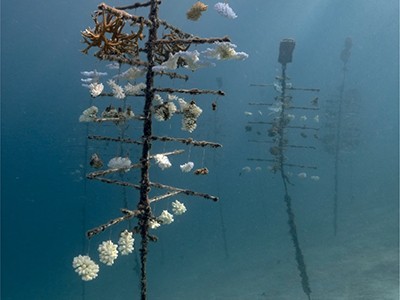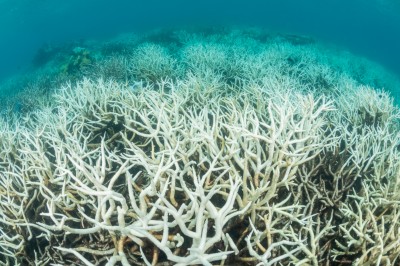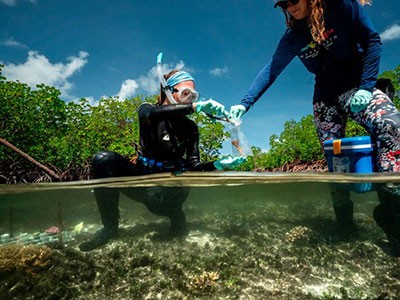I relocated from California to Placencia, on the coast of southern Belize, in 1995, when there were no paved roads, no vehicles and everybody walked around barefoot. Back then, I was working as a research assistant and scuba-diving instructor. That meant that I had access to Belize’s stunning coral reefs, but also that I began to witness — and document — an ever-more depressing decline in the reefs’ health.
In 1999, while managing Glover’s Reef Marine Reserve for the Belize Fisheries Department, I saw the effects of the 1998 global bleaching event caused by an El Niño followed by a strong La Niña — weather patterns resulting from variations in ocean temperatures in the Equatorial Pacific.
Coral reefs deserve evidence-based management not heroic interference
Then in 2001, the category-4 Hurricane Iris hit Placencia and the Laughing Bird Caye National Park 12 miles offshore, causing catastrophic damage. Laughing Bird Caye, part of the Belize Barrier Reef World Heritage Site, is crucial to local tourism. The devastation, for both the reef and the community, got me thinking about whether the corals could be re-established.
Coral-reef restoration or rewilding has since become the subject of often intense debate, with a growing number of scientists maintaining that it is a losing battle in a rapidly warming world. Specialists continue to argue over even such basic questions as ‘what is a coral?’ and ‘what is a reef?’, before you get to ‘how much coral cover restored counts as restoration?’ Some researchers question whether reef restoration can be done at scale, whereas others have made overzealous assertions about how easy it is, what it can achieve and how. Reef restoration has taken off — like yoga, I often joke — with ever-wilder ideas about how to ‘save the reefs’. Instead of ‘yoga with babies’, ‘yoga with goats’ or ‘yoga with snakes’, it’s ‘feed the corals’, ‘shade the corals’ or ‘mix in some probiotics’.
My and my team’s experiences, over almost two decades in Belize, show that coral-reef restoration projects can be an uphill battle. But — for now at least — done in the right way, the work can help the corals, their surrounding ecosystems and the communities that depend on them.
Great Barrier Reef’s temperature soars to 400-year high
It took four years to find funding to trial transplanting coral fragments from Belize’s outer reef to Laughing Bird Caye. But since 2010, a team of Belizeans and I have moved genetically distinct colonies of elkhorn coral (Acropora palmata), staghorn coral (A. cervicornis) and hybrids (A. prolifera) — amounting to more than 96,000 fragments — to Laughing Bird Caye and more than 20 other sites across 7 marine protected areas.
To better assess changes in coral cover, in 2014 we started using an imaging approach called diver-based photomosaics, a type of large-area imaging. Annual analyses of nine plots (each measuring 50–200 square metres) showed that coral cover increased from 4–6% in 2014 to more than 60% in 2021.
In 2019, we began using drones to assess larger areas, and, by 2021, showed that we had re-established live corals in more than 0.2 hectares of reef around Laughing Bird Caye alone. Although survival rates could turn out to be a lot worse this year, even after two major coral-bleaching events in 2023, nearly 80% of 1,200 transplanted A. palmata fragments at four Cayes in southern Belize had survived (these data are yet to be published).
‘Ecological grief’ grips scientists witnessing Great Barrier Reef’s decline
We are trying to keep portions of shallow reefs alive for as long as possible in a warming world, partially in the hope — which admittedly is thinning — that humanity begins to bend the warming curve so that corals can thrive again. But our experiences suggest that these efforts are likely to prove beneficial only if the water quality is good enough, and if living corals and macroalgae grazers are present. Macroalgal mats interfere with the settlement of coral larvae when they switch from their planktonic phase to the sessile one; sea urchins, crabs and other grazers keep levels of macroalgae down. No-take or highly protected marine zones are also crucial because they preserve species such as lobsters, which feed on the snails that feed on corals.
Restoration can have all sorts of benefits. It can provide a habitat for hundreds of species and protect shorelines from erosion and flooding. It can provide an economic boost, too — and not just by driving tourism. In 2013, a group of us founded an initiative called Fragments of Hope to continue our coral-restoration work. Since then, we have employed only people who live in Belize. More than 100 have trained with us so far. Last year, more than 70% of our operating costs (nearly US$250,000 per year) were spent in Belize. Each person who worked with us last year (for 20 hours a week) earned around $5,000. And this year, it will be around $10,000. This is in a country where the minimum wage is $2.50 per hour and the gross domestic product per capita was less than $7,000 in 2023.
Today, around 25 researchers from different disciplines use Fragments of Hope for their work. Environmental engineers are trying to quantify wave attenuation or work out how to improve waste-water treatment, and anthropology students are pursuing socio-economic studies.
I often feel like giving up. But as long as the corals don’t, nor will I. Whenever I see tiny remnants of coral fusing together — often in the space of a year — to create a living coating over what had looked like a huge dead coral skeleton, I am persuaded to keep trying. Fragments of Hope and other interdisciplinary learning hubs should not be abandoned yet.
Competing Interests
The author declares no competing interests.





